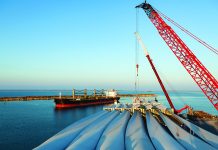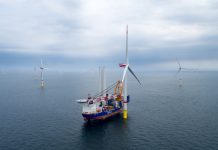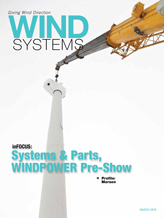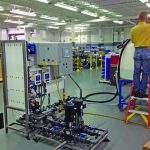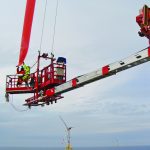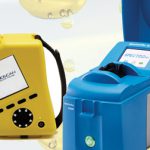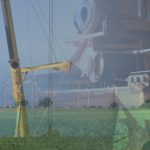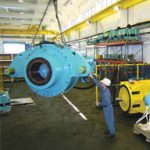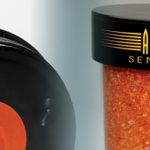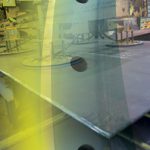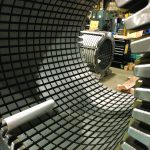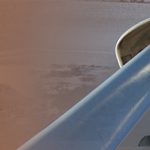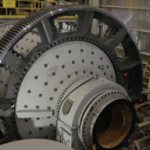Mersen differentiates itself by not just offering a new product that will work better than the previous one, but by rethinking the application in order to offer serious upgrades that can make a real difference.
The European-based Mersen has been operating almost 80 years in North America, and it has become a leader in the wind industry in the U.S., according to Benoit White, global market manager for wind power and power transfer technologies.
“We want our customers to rely on us as the technical experts in the industry,” he said. “We are really focused on performance and the technical aspect of the product more than anything else.”

For the wind industry, Mersen manufactures electrical sliding contacts for power and signal application.
“That’s the core business for our division,” White said. “We do a lot of other things for wind such as fuses and advanced busbars, but when it comes to our business unit, electrical sliding contacts or current collectors is what we focus on.”
Most of the components that Mersen supplies are in the wind generator. They are called slip-rings, brush-holders, and brushes, which are basically the components that connect the converter of the wind turbine to the generator rotor winding, according to White.
Turbine types
There are two main technologies of turbines in the field. One is a fully converted turbine, in which 100 percent of the power generated needs to be rectified to meet the grid requirements. As the wind speed changes, the rpm of the generator changes, hence the need for full power conversion.
The turbines that Mersen’s technology is being used in are the DFIG or double fed induction generator turbines, according to White.

“This technology features many benefits,” he said. “It has been for nearly two decades the most widely spread technology, and that’s where we come in. That’s the technology that we support, because with that technology, only about 20 to 30 percent of the power is converted. This type generator coupled to a DFIG converter produces a clean power directly at the frequency of the grid. And in order to achieve that, we need to control what’s going on in the rotor windings of the generator or, to be more specific, the frequency of the excitation, which means having a power component to control the current inside the generator rotor while in rotation.”
The DFIG turbines tend to be more cost-efficient technology in terms of dollars per megawatt, which means the DFIG technology remains less expensive than a fully converted machine, White said.
“We know the pressures the industry is facing now in the U.S. and in many other countries throughout the world,” he said. “Some of the projects are optioned now, and the lowest bidder gets the project. So, we work actively to keep lowering the cost of the DFIG turbine to ensure it remains the preferred technology out there for the next two decades or more.”
Mersen’s mission, according to White, is to support those technologies and make it even more attractive for large power turbines.
“As the turbines get bigger and bigger, these power components on the generator are also going to get larger and larger, and it’s our responsibility to make these components viable for this technology,” he said. “Our role in the industry is to support that effort and convince the rest of the manufacturers that this is the way to go, and that we can handle the technological challenges.”

Close to customers
In order to help accomplish that goal, Mersen tries to stay close to its customers in the field, according to White.
“We have an extended sales network of people who are certified to climb turbines to perform inspections and support our products and solutions in operations and suggest upgrades” he said. “Having access to the turbines is very important to us, and it’s more than just replacing product A with product B. It helps us truly understand the performance of our solutions and understand the specific needs from each one of our customers. That’s what we’ve really been focusing on: Always working to improve reliability of the system, and lower the total cost of ownership by creating customized solutions for our customers.”
And a lot of times, those customized solutions actually begin with the customer.
“We have a typical process when we see there is room for improvement or when the customer is concerned about something or when we see that something could be done better or designed better,” White said. “We have the capability of bringing that back to the design office and designing something different as a drop-in replacement to improve the overall performance.”
Mersen calls that a retrofit or redesign. Although Mersen manufactures its solutions in large quantities, it has the flexibility and capability to rapidly manufacture prototypes that can be taken to a customer and tested for a specific application up-tower, according to White. New products often originate from customer-specific needs, feedback, and experimentation.

“Although Mersen is one of the largest suppliers to the generator OEM and turbine OEM, what we have found — at least for us in wind — is that our biggest success stories and the biggest sellers that we have are often products that are born like that — when it’s initiated through a partnership with a customer and re-thinking a product, perfecting it, and validating it,” he said. “Having that connection is very important.”
Re-powering
Mersen is heavily involved in the trend of re-powering older turbines, according to White.
“The game has changed,” he said. “Before, the turbines would come out of the factory, be commissioned, and operate at their original nominal rated power for years and years. But now the turbines are changing. Manufacturers offer their existing customers a boost in power or a power up-rating. But it basically means that out of the same turbine, the same hardware, through a software upgrade, turbines get pushed a little further to optimize the power curve: for example, a 2 MW turbine can now produce 2.2 MW and this can cause additional stress on the turbine components. And what we’ve done successfully is to design ranges of solutions to support that and handle the additional loads.”
As turbines are uprated or re-powered, a lot of the internal components have to be reconsidered, according to White.

“Sometimes the hardware upgrade is not taken into account, and once the power of the machine has been upgraded, then we could start seeing phenomena that we didn’t see in the past,” he said. “We have designed solutions that support that upgrade that are very easy to implement — minimal changes to the machine with more robust components, advanced materials, more heavy duty, that are able to support that new trend. That’s the focus of our next upcoming ad campaign.”
Leading technology
As Mersen enters its next decade, White said the DFIG technology will continue to lead the industry.
“Our goal is to support that and to make that technology the best technology out there,” he said. “Without a proper reliable slip ring and brush and brush holder system, the DFIG technology doesn’t work.”
White said Mersen will be exhibiting at WINDPOWER 2018 in Chicago in May. Among what attendees should expect are Mersen’s signal and power transfer systems (SPTS). It’s also called a hub slip ring, and it is the compact slip-ring that sits on the low speed end of the gearbox and sends signal and power back-and-forth from the nacelle to the hub in order to communicate with all the electronics and even actuate the pitch the blades.

“We spent a lot of R&D in making this product more reliable,” he said. “And we’re coming out this year with a range of products for many different turbines, and I know we’re going to be exhibiting that. But our big focus remains to support customers through their power up-rate programs and present them with options best suited to their specific requirements.”
Helping customers harkens back to Mersen’s core goal of being more than just a product supplier but a solution provider, according to White.
“We share the experience; we share the success stories, and we show how our solutions can help with that,” he said. “Expertise is our source of energy.”

















